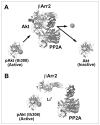A role for Akt and glycogen synthase kinase-3 as integrators of dopamine and serotonin neurotransmission in mental health
- PMID: 21711983
- PMCID: PMC3244494
- DOI: 10.1503/jpn.110011
A role for Akt and glycogen synthase kinase-3 as integrators of dopamine and serotonin neurotransmission in mental health
Abstract
Mental illnesses, such as bipolar disorder, attention-deficit/hyperactivity disorder, depression and schizophrenia are a major public health concern worldwide. Several pharmacologic agents acting on monoamine neurotransmission are used for the management of these disorders. However, there is still little understanding of the ultimate molecular mechanisms responsible for the therapeutic effects of these drugs or their relations with disease etiology. Here I provide an overview of recent advances on the involvement of the signalling molecules Akt and glycogen synthase kinase-3 (GSK3) in the regulation of behaviour by the monoamine neurotransmitters dopamine (DA) and serotonin (5-HT). I examine the possible participation of these signalling molecules to the effects of antidepressants, lithium and antipsychotics, as well as their possible contribution to mental disorders. Regulation of Akt and GSK3 may constitute an important signalling hub in the subcellular integration of 5-HT and DA neurotransmission. It may also provide a link between the action of these neurotransmitters and gene products, like disrupted in schizophrenia 1 (DISC1) and neuregulin (NRG), that are associated with increased risk for mental disorders. However, changes in Akt and GSK3 signalling are not restricted to a single disorder, and their contribution to specific behavioural symptoms or therapeutic effects may be modulated by broader changes in biologic contexts or signalling landscapes. Understanding these interactions may provide a better understanding of mental illnesses, leading to better efficacy of new therapeutic approaches.
Figures




References
-
- Hoyer D, Hannon JP, Martin GR. Molecular, pharmacological and functional diversity of 5-HT receptors. Pharmacol Biochem Behav. 2002;71:533–54. - PubMed
-
- Kapur S, Remington G. Atypical antipsychotics: new directions and new challenges in the treatment of schizophrenia. Annu Rev Med. 2001;52:503–17. - PubMed
-
- Snyder SH. The dopamine hypothesis of schizophrenia: focus on the dopamine receptor. Am J Psychiatry. 1976;133:197–202. - PubMed
-
- Torres GE, Gainetdinov RR, Caron MG. Plasma membrane monoamine transporters: structure, regulation and function. Nat Rev Neurosci. 2003;4:13–25. - PubMed
Publication types
MeSH terms
Substances
Grants and funding
LinkOut - more resources
Full Text Sources
Medical
Molecular Biology Databases

